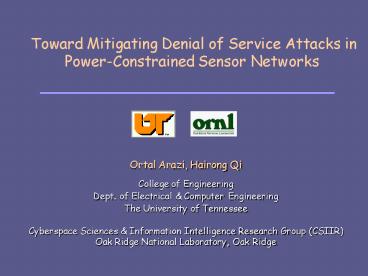Toward Mitigating Denial of Service Attacks in PowerConstrained Sensor Networks - PowerPoint PPT Presentation
Title:
Toward Mitigating Denial of Service Attacks in PowerConstrained Sensor Networks
Description:
The CA's signature on the association between nA and IDA. The Denial ... Each node is given by the CA (Certifying authority) a set of public and private keys: ... – PowerPoint PPT presentation
Number of Views:82
Avg rating:3.0/5.0
Title: Toward Mitigating Denial of Service Attacks in PowerConstrained Sensor Networks
1
Toward Mitigating Denial of Service Attacks
inPower-Constrained Sensor Networks
Ortal Arazi, Hairong Qi College of
Engineering Dept. of Electrical Computer
Engineering The University of Tennessee Cyberspac
e Sciences Information Intelligence Research
Group (CSIIR) Oak Ridge National Laboratory, Oak
Ridge
2
Instigating Communication
Bob
Alice
Lets talk
Insecure channel
Alice and Bob legitimate users They would like
to start communicating
key? talk?
3
Denial of Service Mitigation
Trudy
Bob
Insecure channel
Trudy wants to 1) Drain Bobs energy
2) Impede him from talking to
other legitimate users How can we
prevent that?
4
Denial of Service Mitigation Procedure
Alice
Bob
Part A
Alice proving to Bob her validity
A relatively energy draining procedure on Trudys
side
If Proved
Part B
Bob proving to Alice his validity
A relatively non energy draining procedure on
Bobs
side
If the authentication is
successful, as a result
Alice and Bob will also
have a shared key
5
The Denial of Service Mitigation Part A
(nA, e)? Alices public key (nA, dA)?
Alices private key CRA ? Alices
certificate IDA ? Alices identification
CR- A certificate The CAs signature on the
association between nA and IDA
6
The Denial of Service Mitigation Part A (cont)
7
Timing and energy considerations (Part A)
160 mJ 250 msec (for a 512 bit key) All other
energy and time consumptions (from the other
procedures) are negligible
8
Calculating the keys
( nA,e)? Alices public key (nA,dA)?
Alices private key
Pi- Pseudo random prime number
Eulers Totient Function returns the
number of Integers less than nA
9
Checking the Certificate
nCA and dCA are calculated using the exact
procedure indicated above
10
The Denial of Service Mitigation Procedure
11
The Denial of Service Mitigation Part B
I am Bob!
??
- How can Bob prove his validity?
- Several solutions
- Using the self-certified fixed key method
- Using RSA
- Using ECDSA
12
The Denial of Service Mitigation Part B
(1) Using the self-certified fixed key method
t
When calculating the self-certified fixed key,
Bob is authenticated! Both have the message m
Bob sent in part A
Y LSB of m
xAH(IDB , UB) UB R ,
xBH(IDA , UA) UA R
The final ephemeral key f( fixed key, m/without
the Y LSB sent on the open channel)
13
Self certified DH key generation Fixed key
Each node is given by the CA (Certifying
authority) a set of public and private keys (Uv,
Xv)
Node i
Node j
IDj , Uj
IDi , Ui
Node i calculates xiH(IDj , Uj), Uj R
xjH(IDi , Ui), Ui R Node j calculates
IDv identification of node v
- scalar Uv node vs public
key, generated by the CA - a point on
the curve Xv node vs private key, generated
by the CA - scalar
14
Self certified DH key generation Fixed key
mathematical assertions As given by the
CA Ui hi G
Uj hj G xi H(IDi, Ui),
hi d mod org G xj H(IDj,
Uj), hj d mod org G
Node i calculates xiH(IDj , Uj), Uj R
xiH(IDj , Uj), hj G dG xiH(IDj ,
Uj), hj d G xi xj G
Node j calculates xjH(IDi, Ui), Ui R
xiH(IDi, Ui), hi G dG xiH(IDi ,
Ui), hi d G xj xi G
R the CAs public key dG
- a point on the
curve d the CAs private key
- scalar G
a generating group-point, used by all relevant
nodes - a point on the curve hv a random
160 bit number generated by the CA -
scalar
15
The Denial of Service Mitigation Part B
(2) Using RSA
CRB IDB nB SB
- Bob calculates
- Bob send Alice
- Alice calculates
If so, the final ephemeral key Z
16
The Denial of Service Mitigation Part B
(3) Using ECDSA
- Bob
- Generates a random number u. Calculate
. C- the scalar representation
of point V. - Calculates
.
The signature is the pair (C,L) - Sends Alice (C,L)
- Alice
- Computes
- Obtains the curve point
C- the scalar
representation of point P - If CC, then the signature is valid, it is Bob!
If so, the final ephemeral key Z
17
The Denial of Service Mitigation, Part
B Comparing the three methods
The time is measured in ECC point by scalar
multiplications Approximately 40 msec
18
Conclusions
- PKC implementation in WSN is feasible
- ECC shows promise as crypto technology
- DoS is a primary threat
- Introduced a hybrid RSA/ECC framework for
mitigating DoS attacks - Using the fixed key approach or the ECDSA
approach proved to be highly beneficial
19
- Thank You
- Questions ?































